
Nondisplaced comminuted fracture of shaft of unspecified tibia, subsequent encounter for open fracture type IIIA, IIIB, or IIIC with malunion Save
ICD-10 code: S82.256R
Disease category: S82.256: Nondisplaced comminuted fracture of shaft of unspecified tibia
Nondisplaced Comminuted Fracture of Shaft of Unspecified Tibia: Understanding Malunion
A nondisplaced comminuted fracture of the shaft of the tibia refers to a specific type of fracture where the bone in the lower leg has broken into multiple pieces, but the fragments remain aligned and in their original position. This injury is commonly encountered in accidents or high-impact trauma. When this fracture heals in an abnormal position, it is referred to as malunion. This article aims to provide a brief overview of malunion associated with a type IIIA, IIIB, or IIIC open fracture subsequent encounter.
When a nondisplaced comminuted fracture of the tibia undergoes malunion, it means that the bone has healed in a way that causes deformity or misalignment. Malunion can lead to various complications, including altered joint mechanics, limb-length discrepancy, and potential chronic pain. The severity of these complications depends on the extent of the malunion and the specific type of open fracture.
- Malunion in Type IIIA Open Fracture:
- Malunion in Type IIIB Open Fracture:
- Malunion in Type IIIC Open Fracture:
In a type IIIA open fracture, the skin has been pierced by the fractured bone but does not suffer extensive soft tissue damage. If this fracture subsequently malunites, it may result in minor functional limitations and aesthetic concerns. However, the risk of infection or other complications is relatively low.
Type IIIB open fractures involve significant soft tissue loss and damage, making them more severe. If malunion occurs in this context, it can lead to substantial functional impairment, increased risk of infection, and possible amputation.
Type IIIC open fractures represent the most severe cases, involving arterial injury and potential loss of blood supply. Malunion in these cases can have catastrophic consequences, including limb-threatening complications and a high risk of amputation.
Proper management of malunion associated with nondisplaced comminuted fractures of the tibia is crucial to minimize complications and optimize functional outcomes. Treatment options may include corrective osteotomy, external fixation, internal fixation, or a combination of these approaches. However, it is important to consult with a qualified healthcare professional for an accurate diagnosis and appropriate treatment plan.
In conclusion, malunion is a potential complication of a nondisplaced comminuted fracture of the tibia, particularly in open fractures of type IIIA, IIIB, or IIIC. Understanding the severity of malunion based on the type of open fracture is essential for effective management and prevention of long-term complications.
Treatment of Nondisplaced comminuted fracture of shaft of unspecified tibia, subsequent encounter for open fracture type IIIA, IIIB, or IIIC with malunion:
Treatment Options for Nondisplaced Comminuted Fracture of the Shaft of Unspecified Tibia
A nondisplaced comminuted fracture of the shaft of the tibia can be a significant injury, requiring appropriate treatment to ensure proper healing and avoid complications. When the fracture has not shifted out of position (nondisplaced) but has multiple fragments (comminuted), treatment options...
To see full information about treatment please Sign up or Log in